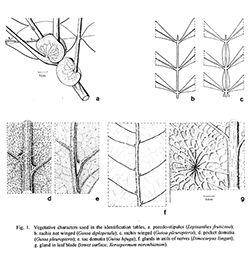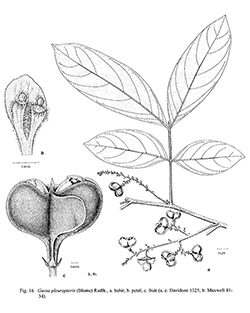e-Flora of Thailand
Volume 7 > Part 1 > Year 1999 > Page 205 > Sapindaceae > Guioa
3. Guioa pleuropteris (Blume) Radlk.wfo-0000711881
Sapind. Holl.-Ind.: 10. 1879; in Engl., Pflanzenr. 98: 1164. 1933; Gagnep. in Fl. Gen. I.-C., Suppl. 1: 981, f. 124: 17–26. 1950; Yap in Tree Fl. Mal. 4: 442. 1989; Welzen, Leiden Bot. Ser. 12: 257, f. 109, 110. 1989 (see also for complete synonymy); in Fl. Males., Ser. 1, Spermat. 11: 584, fig. 386, 41, 42. 1994.— Cupania pleuropteris Blume, Rumphia 3: 148. 1847. Fig. 1c, d. Fig. 16.
Accepted Name : This is currently accepted.
Synonyms & Citations :
Description : Shrubs to trees up to 30 m high; outer bark usually smooth, usually dark brown with white and grey. Leaves (1–)2–5(–7)-jugate, rachis often winged. Leaflets elliptic to obovate, lower ones much smaller than upper ones, 0.9–18.7 by 0.5–8.3 cm, especially basally asymmetrical, (sub)coriaceous; base mainly attenuate; margin entire; apex (obtuse to) usually abruptly acuminate; domatia many; papillate and hirsute (to subglabrous) beneath. Inflorescences up to 22 cm long. Flowers whitish to pink, 3–4.2 mm in diam. Sepals ovate, 0.7–3.5 by 0.6–3.3, petaloid. Petals mainly obovate, 1.3–3.5 by 0.7–2.2 mm; claw 0.2–1 mm high; scales 0.8–2.2 mm high, apex not broadened, bifid. Stamens: filaments up to 5.1 mm long; anthers 0.2–0.7 mm long. Fruits red, 1–1.9 by 1–2.5 cm; stipe 2–5 mm high; wall thin, leathery. Seeds brownish black, 5.5–9.7 by 5–8 mm; arillode yellow to orange.
Thailand : SOUTH-EASTERN: Chanthaburi (Amphoe Muang, Khao Sabab, Makham, Nong Bon, Phlio Falls, Pong Rat), Trat (Ko Chang, Ko Kut, Takum); PENINSULAR: Chumphon (Bang Son, Khao Muttri, Paknam), Surat Thani (Ko Pa-ngan), Nakhon Si Thammarat (Ban Yan, Khao Chum Tong, Tha Sala Kalo, Thung Song), Songkhla (Hat Yai, Klong Rhang Khao), Pattani (Khao Ken, To Mo), Yala (Banang Sata), Narathiwat (Bacho, Bukematong, Rue So).
Distribution : Burma, S Cambodia, S Vietnam, Malay Peninsula, Sumatra, Borneo (type), the Philippines.
Ecology : Rare to very common in flat to mountainous land, dry to periodically flooded. Primary and especially secondary forests, edges of forests, plantations, in secondary regrowths, cultivated land, moss forests, along riverbanks, roads and on the sea shore, on a variety of soils, sea level up to 1,800 m alt. Flowering: August–March (–May); fruiting throughout the year, mainly February–April.
Vernacular : Taet ling (แตดลิง)(Southeastern, Peninsular); dok din (ดอกดิน), ka ling (กะลิง), ling (ลิง), mai sifan (ไม้สีฟัน), pa tae ling (พะแต้ลิง), sifan (สีฟัน), som ling (ส้มลิง), thop taep (ถอบแถบ)(Peninsular); ka-lu-pae ya-mo (กะลูแปยาโมะ)(Malay-Narathiwat).
Uses: Wood is durable and elastic, though thin, and used for handles of tools and shafts of wagons and ploughs, also as torches. The roots are used as a decoction in N.E. Pahang (Malaysia) against fever and stomach ache. The arillode is edible, but sourish and thin.
Notes: A widespread species, but mainly variable in its indumentum, with a tendency to being glabrous in Thailand. Only in North Borneo and the Philippines the shape of the leaflets becomes very variable along two geographical clines.


